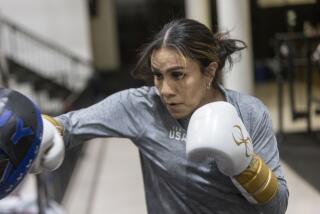Ronda Rousey and other MMA fighters widen their arsenals
- Share via
At its birth, mixed martial arts were a competition of fighters from different disciplines — boxing, wrestling, karate, kickboxing, jiujitsu — battling to establish which version of combat was best.
Now, the sport of MMA can encompass all of those skills in one fight. In one fighter.
“Guys have trained now in MMA from a younger age. They weren’t a high school wrestler like me who had to learn the other aspects one by one,” said veteran MMA fighter Dan Henderson, 41.
One of the sport’s latest advancements is personified by the new Strikeforce women’s bantamweight champion, Ronda Rousey of Venice. Rousey’s judo-based stand-up clinches have produced a string of first-round victories, including her title win in March over then-champion Miesha Tate.
A 2008 Olympic bronze medalist in judo, Rousey used the discipline to bear-hug Tate and throw her down, setting up Rousey’s preferred method of execution on the canvas: grabbing and twisting the foe’s arm until the pain prompts a tap-out to surrender.
“Judo is an underutilized fighting style and very unorthodox,” Rousey said. “The guys in MMA are working on it, but the girls are not equipped to deal with it. Judo requires good posture, so the girls I’ve fought can’t tell if I’m coming in to clinch or strike.… It’s won me every single one of my fights.”
So in watching the 2012 London Olympics, bear in mind the next generation of professional MMA fighters could be coming from the amateur wrestling mat, or taekwondo. And from judo.
“What these ‘judo players,’ as the fighters call them, are doing is one of the more effective martial arts,” the Ultimate Fighting Championship Chairman Lorenzo Fertitta said.
“It’s been quite interesting to watch this progression, with these fighters introducing a new technique or move that brings you to your feet. It’s what makes this sport so intriguing — the athletes’ ability to be creative and come up with moves that before were unknown.”
Fertitta has had a front-row seat to the development in styles dating from 2002, when he purchased the fledgling UFC, a time when bouts had almost no rules, no weight classes, and fights lasted up to 30 minutes or until a knockout.
In the beginning, the dominant fighter was Brazilian jiujitsu expert Royce Gracie, who won UFC 1.
“Back then, before the five-minute rounds, a smaller opponent with good endurance had the advantage,” Gracie said. “I’d get a guy down, and ultimately get him in a position of submission. Those tournaments were some long fights. In fact, UFC 4 ended minutes over the two-hour cable time the UFC had bought.
“For the sport to grow, they had to create rules.”
MMA fighting is now sanctioned in nearly every state, dividing fighters into numerous weight classes and limiting non-title bouts to three rounds. Knees or kicks to the head when an opponent is on the ground are banned, as are certain holds. Referees typically step in quickly to stop bouts when a fighter is subject to excessive punishment.
These changes spawned a more aggressive, brawling type of fighter in the mold of Chuck Liddell, Ken Shamrock and Tito Ortiz, who took a bar-fight mentality into the octagon, with Ortiz using a high school wrestling background to implement his ground-and-pound method.
“Ground and pound doesn’t work anymore,” Gracie said. “People today have too strong of a defense. You still have to know submission. On the ground, Gracie jiujitsu submissions still work.
“You learn boxing, striking, karate, taekwondo — and wrestling and judo come in because you have to know how to apply and defend against a takedown. But you always need to know your jiujitsu.”
Today, the most talented MMA fighters have a mix of strategies they can call on, plus mental toughness, said Gracie. He praises UFC light-heavyweight champion Jon Jones, middleweight champion Anderson Silva, welterweight champion Georges St-Pierre and lightweight champion Benson Henderson for being the most mentally superior.
“You might believe your opponent’s coming forward with their right foot and right hand because they did it last fight, but then they come with the left foot and left hand,” Gracie said.
“Suddenly, you don’t know who you’re fighting, or what they’re going to do. There’s no such thing as easy in these fights. No more can you come into the octagon and say, ‘Let’s duke it out.’ The tough guy doesn’t win the fight. It’s the guy with the perfect strategy.”
And more than ever, Fertitta said, his fighters are standing on equal footing in the conditioning department with NFL and NBA athletes.
“Not to take anything away from the Royce Gracies,” Fertitta said, but “Jon Jones has trained beyond his wrestling in MMA for years. He doesn’t feel as if he has any weakness in there, and strives with his size and length to be a free-flow fighter with moves that have never been seen before like his spinning back-fists.”
That is the challenge facing UFC veterans such as Dan Henderson, who’ll challenge Jones for the light-heavyweight title Sept. 1 at Mandalay Bay in Las Vegas.
And veteran MMA fighter Urijah Faber, 33, found himself beaten July 21 by one of the UFC’s new breed of superb athletes, 25-year-old Renan Barao, in an interim 135-pound bantamweight championship bout in Canada. But Faber’s appearance in the title fight was a tribute to his ability to remain open to the changing sport.
“Guys are more well-rounded than they’ve ever been, but it still comes down to having the right mentality — a fighter’s mentality,” Faber said.
“I’ve made it a point to always seek out that stuff and try it — embrace the journey, you know? Those who didn’t, you don’t hear from them anymore.”
Henderson said he too has welcomed the “fun” of making himself as versatile as possible.
However, don’t expect him to mimic Jones’ acrobatic act in their title bout, as old-school MMA meets today’s prototype.
“I’m just going to stay in his face and get in a brawl,” Henderson said. “He’s long, awkward and dangerous, but it’s a matter of avoiding his goofy elbows and making him fight my fight.”
Meanwhile, Gracie, now 45, is in a different place. He sees the youthful skill and power, and expresses no interest in returning to the octagon.
“Let the young guys do their thing,” he said. “I’m done.”
twitter.com/latimespugmire
More to Read
Go beyond the scoreboard
Get the latest on L.A.'s teams in the daily Sports Report newsletter.
You may occasionally receive promotional content from the Los Angeles Times.







